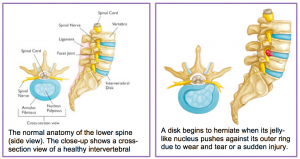Disc Herniation
Herniated Disk
A common source of back or neck pain is a herniated disk. Sometimes called a “slipped” or “ruptured” disk, this condition most often occurs in the lower back, as well as the smaller disks in the neck.
Although a herniated disk can sometimes be very painful, most people feel much better with just a few months of simple, nonsurgical treatments.
Anatomy
Disks are soft, rubbery pads found between the hard bones (vertebrae) that make up the spinal column. The disks between the vertebrae allow the back to flex or bend. Disks also act as shock absorbers.
Disks in the lumbar spine (low back) are composed of a thick outer ring of cartilage (annulus) and an inner gel-like substance (nucleus). In the cervical spine (neck), the disks are similar but smaller in size.
Cause
A disk herniates or ruptures when part of the center nucleus pushes through the outer edge of the disk and back toward the spinal canal. This puts pressure on the nerves. Spinal nerves are very sensitive to even slight amounts of pressure, which can result in pain, numbness, or weakness in one or both legs.
Risk Factors
In children and young adults, disks have high water content. As people age, the water content in the disks decreases and the disks become less flexible. The disks begin to shrink and the spaces between the vertebrae get narrower. Conditions that can weaken the disk include:
- Improper lifting
- Smoking
- Excessive body weight that places added stress on the disks (in the lower back)
- Sudden pressure (which may be slight)
- Repetitive strenuous activities
Symptoms
Lower Back
Low back pain affects many people. Pain alone is not enough to recognize a herniated disk. See your doctor if back pain results from a fall or a blow to your back. The most common symptom of a herniated disk is sciatica—a sharp, often shooting pain that extends from the buttocks down the back of one leg. It is caused by pressure on the spinal nerve. Other symptoms include:
- Back pain
- Weakness in the leg and/or foot
- Tingling (a “pins-and-needles” sensation) or numbness in the leg and/or foot
- Loss of bladder or bowel control (This is rare and may indicate a more serious problem called cauda equina syndrome. This condition is caused by the spinal nerve roots being compressed. It requires immediate medical attention.)
Neck
As with pain in the lower back, neck pain is also common. When pressure is placed on a nerve in the neck, it causes pain in the muscles between your neck and shoulder (trapezius muscles). The pain may shoot down the arm. Other symptoms include:
- Weakness in one arm
- Tingling (a “pins-and-needles” sensation) or numbness in one arm
- Burning pain in the shoulders, neck, or arm

